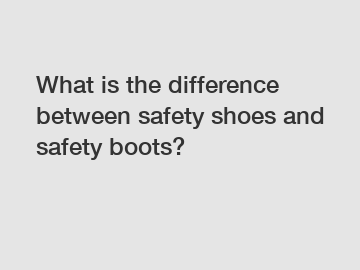Feb. 12, 2024
Shoes & Accessories
When it comes to workplace safety, proper protective footwear is of paramount importance. Employers and employees must pay careful attention to the type of footwear they choose, as it can greatly impact worker safety and productivity. Safety shoes and safety boots are two popular options, but understanding their differences is essential for making an informed choice. In this blog, we will explore the dissimilarities between safety shoes and safety boots to help you make the right footwear decision for your specific needs.
1. Safety Shoes: Ensuring Precision and Agility.
Safety shoes are designed to offer both comfort and protection in work environments that may pose various risks to the feet. These shoes typically have an athletic appearance and low-top design. They prioritize agility, precision, and ease of movement for tasks that demand agility and quick reflexes. Safety shoes are ideal for workers who need to move swiftly, such as warehouse staff, delivery personnel, or professionals in manufacturing industries.

These shoes often incorporate a reinforced toe cap, which can be made of composite materials like fiberglass or plastic, or steel for maximum toe protection. Moreover, safety shoes frequently feature puncture-resistant soles and electrical hazard protection to shield workers from potential accidents and electrical shocks. As they resemble regular footwear, safety shoes are also more suitable for industries with less strict dress code requirements.
2. Safety Boots: Elevated Protection for Heavy-Duty Environments.
Safety boots, on the other hand, are specifically engineered for physically demanding workplaces that expose workers to more severe hazards. These boots usually extend beyond the ankle and have a higher collar, providing superior ankle support and minimizing the risk of sprains. The taller design ensures the foot and lower leg are safeguarded against falling objects, uneven terrain, and hazardous substances.
One of the distinguishing features of safety boots includes the added protection on the instep and heel, which is crucial for workers in heavy industries such as construction, forestry, or mining. These boots often comprise a robust steel toe cap, offering top-level impact resistance. Furthermore, safety boots may include features like metatarsal guards, heat insulation, waterproofing, and resistant soles to withstand extreme weather conditions or the presence of corrosive substances.
Further reading:3. Making the Best Choice for Your Workplace:
Understanding the specific requirements of your workplace is crucial in choosing between safety shoes and safety boots. Here are a few key factors to consider:
a. Nature of Hazards: Evaluate the type and severity of hazards present in your workplace. If your job entails heavy lifting, working with heavy machinery, or exposure to harsh chemicals, safety boots are likely the more suitable choice. However, if your tasks involve more agility and maneuverability, safety shoes should be your preferred option.
b. Comfort and Ergonomics: Consider the duration and intensity of work performed. Safety shoes provide great comfort for workers who need to be on their feet all day, whereas safety boots, with their reinforced structure, may require an adjustment period. Optimal comfort promotes job satisfaction and reduces the risk of workplace accidents due to distraction or fatigue.
c. Climate and Work Environment: Take into account the prevailing weather conditions and surroundings. Cold or wet climates often warrant the need for safety boots with insulation and waterproofing properties. Assessing the ground conditions, such as slippery surfaces or uneven terrain, will also help determine the necessary footwear attributes.
Conclusion:
Whether you choose safety shoes or safety boots, prioritizing workplace safety cannot be overstated. By understanding the differences between these protective footwear options and considering factors unique to your work environment, you can select the right footwear to safeguard yourself or your employees. Remember, investing in appropriate protective footwear not only reduces the risk of injuries but also promotes productivity, confidence, and well-being in the workplace.
If you want to learn more, please visit our website Wholesale PVC work boots, Insulation Resistance Rubber Boots, pvc safety boots for mining industry.
Further reading:Related Articles
If you are interested in sending in a Guest Blogger Submission,welcome to write for us!
All Comments ( 0 )